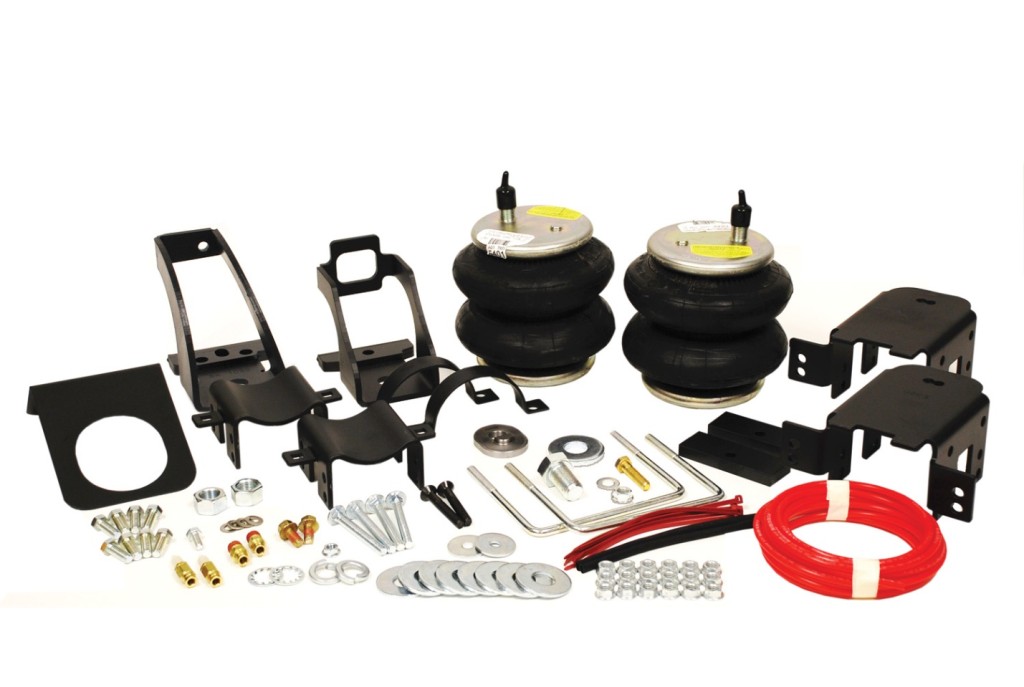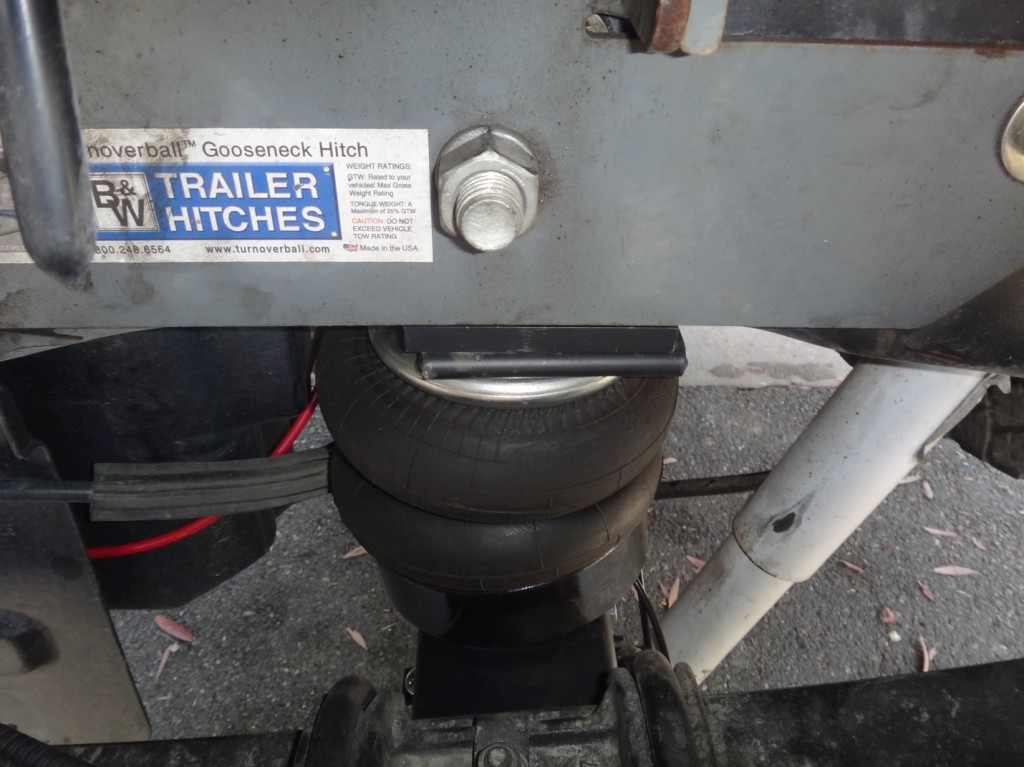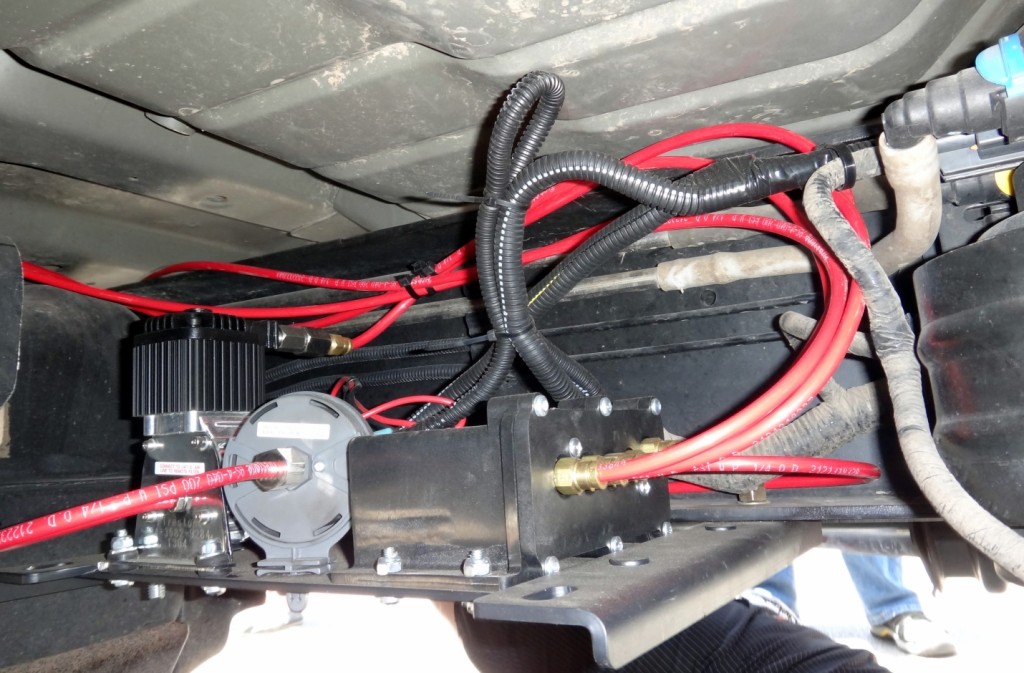
If you do much hauling or towing with a pickup truck, you might consider investing in a set of rear airbags. Most pickup trucks made in the last 15 years have relatively soft rear suspension, and when loaded up will sag in the rear. This can cause rough ride, potential handling issues,vibration from weird pinion angles, as well as the risk of blinding oncoming traffic with headlights along with a number of other problems.
Airbags have been used for many years in the heavy truck, train and bus industry, with most now exclusively using air springs in many applications. This same technology can also be applied to a pickup to ease a number of suspension-related issues. The biggest advantage over more conventional suspension (leaf springs, coil springs, torsion bars etc.) is that static ride height and effective spring rate can be adjusted for the appropriate conditions.
Our 2012 Ford F250 is fitted with a gooseneck hitch, so we looked at the Firestone range of Ride-Rite™ Air Helper Springs (model 2535), a cost effective solution which is added to the existing rear suspension. The ability to adjust the pressure from 5-100psi makes the airbag a flexible and feasible alternative. In the F250, they sit inside of the rear springs, replacing the bump stops that bolt to the chassis.
The airbags can be manually controlled with a regular Schrader tire valve for each bag. However, this process requires an air compressor for adjustment, and eliminates any adjustment while travelling. As a result, we decided to fit Firestone’s Wireless Air Command II, which retains separate control of the left and right airbags (maintaining stability) and enables us to easily increase/decrease air pressure in either or both airbags when hitching up trailers and also while travelling.
The install of the Ride-Rite air springs was very straight forward, and only took us a few hours; the instructions provided are comprehensive and the process relatively simple.
Airbags fitted:
Installing the wireless controller was more difficult. The kit is certainly comprehensive and well thought out (ample fasteners, all wiring was pre-sheathed etc.) The instructions less so. The biggest challenge was figuring out where to mount the kit on the truck. Indicating a location in the instructions, or suggesting the purchase of a mounting plate would make a significant difference. In the end, we figure out to purchase an additional mounting plate (part number F2529) and fit the compressor and manifold on the inside of the frame rail, out of most of the dust and water spray from the front tires. Once we got the mounting plate and figured out where it made the most sense to mount it, the install was smooth sailing.
While the kit looks complex, there really isn’t much to it; it’s just a compressor, an electrically controlled air manifold, a wireless controller and air lines which go to each airbag. So once we worked out where everything needed to go, it didn’t take long to complete the install. All bolted up, the electrical system was very simple: a positive wire to battery, a wire to ground, and a signal wire for ignition on. The manifold also has a manual control (ACC) which can activate the compressor/exhaust valve by holding down the button manually to inflate tires which is a very useful addition. Just attach it to the tire, select the desired pressure on the controller and the system will inflate until it reaches that pressure providing a real-time pressure reading.
The controller is easy to use, includes three savable memory pressure readings, and allows inflation of each airbag separately to compensate for uneven loads (although we recommend you distribute your load as evenly as possible anyway). The kit also includes a 12V Micro USB charger to recharge the controller’s batteries. A ding to let us know the pressure had been reached would be a great upgrade for the next generation, but the lack of one is a very minor issue.
Overall the airbags really transform the trucks handling when loaded. With 80psi in the bags with a truck camper on board, the ride is substantially better; the truck sits flat, and body roll is minimal. The wireless controller makes it very easy on both the installation (no wires or air lines running into the cabin) – and easy to use when outside the vehicle when hitching/loading. We were even more surprised to report that with 15psi in both airbags, but nothing in the bed, the truck was still more comfortable than it had been stock.
The airbags will run you about $350, and the air controller/compressor around $850.







Some example pricing would have been nice. I know I can look this up, but ball park figures could have helped me decide whether or not it was worth my time to do so.
Thanks for the feedback, we appreciate it. We’ll add the price into the article now. In case you were wondering, you can usually find the airbag kit we used for about $350 at the time of writing – most Firestone kits for most trucks are around this price point. The controller kit we paid about $850 – both from Amazon. We hope that helps.